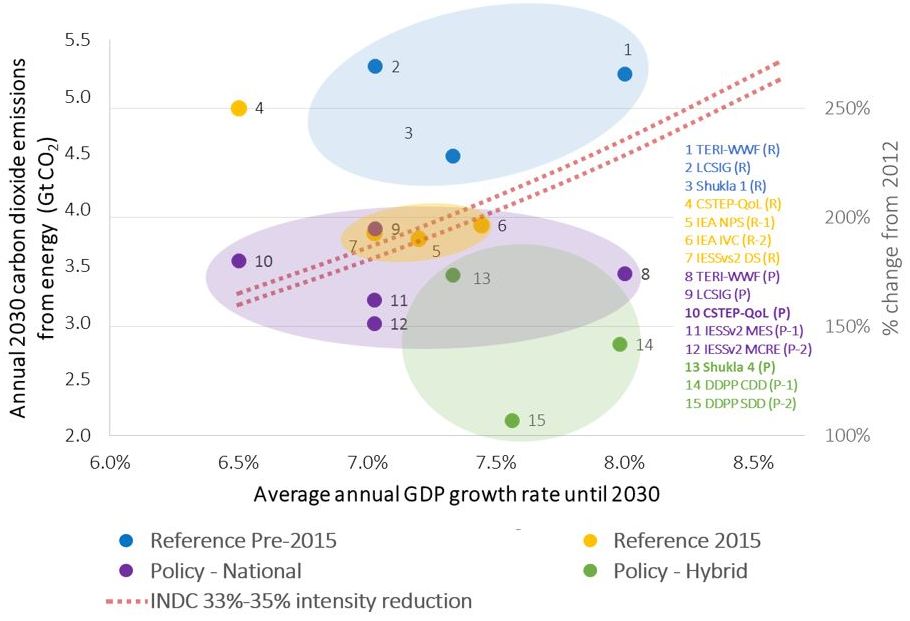India is an important player in global climate change mitigation, and it is crucial to understand its energy and emissions future. Projections for India’s 2030 CO2 emissions from energy range from 9% to 169% above 2012 levels – a small increase to well over a doubling in 18 years. Based on an interpretive review of seven studies, this article concludes that a doubling of CO2 emissions is a likely upper bound and that this trajectory is consistent with India’s Paris pledge.
India has historically been wary of global climate negotiations, concerned that external pressure to mitigate greenhouse gas (GHG) emissions could impinge on its ability to access and use sufficient energy for development and growth. At one level, this concern is understandable: while India will need to use considerable amount of energy in the future, it has so far contributed relatively little to the stock of GHG that lead to global warming, and its emissions per capita remain well below the global average – a common argument put forward by many developing countries. The counter-argument, however, often articulated by wealthier countries, is that India is now the world’s third largest contributor to annual emissions, and the extent of India’s future emissions will have a material impact on global climate change. Moreover, as a country that is highly vulnerable to climate impacts due to factors such as dependence on agriculture, reliance on the monsoon, and limited ability to withstand extreme weather events, India’s interests lie in aggressive global mitigation.
This North-South debate about who is at fault for driving global climate change and therefore which set of countries should bear the primary responsibility to act, has dominated, and paralysed global discussion for two decades. The 2015 Paris Agreement sought a new approach: each country is required to pledge its own contribution towards future emission reduction, consistent with its anticipated development and economic needs. While there are different opinions on its wisdom (Dubash 2017, Narain 2015, Sethi 2015), there is little doubt that this approach represents the future of the global regime, and that it has shifted the calculus for countries. In a post-Paris Agreement world, the primary analytical task ahead for each country is to better understand its likely future
What, then, is India’s likely emissions future? What are the underlying energy needs for development that drive this emissions trajectory? And what can India reasonably pledge in the international negotiations process? We explore these questions based on our recent work (Dubash et al. 2018).
An interpretive review of existing scenario studies
Getting a firm grip on India’s energy and emissions future is a challenging task. Our review of seven leading studies – CSTEP (Center for Study of Science, Technology and Policy), 2015; IEA (India Energy Outlook), 2015; NITI (National Institution for Transforming India) Aayog, 2015; Planning Commission, 2014; Shukla et al. 2015a (Deep Decarbonization Pathways Project); Shukla et al. 2015b; and WWF-India (World Wide Fund for Nature) and TERI (The Energy and Resources Institute), 2013 – reveals projections for India’s 2030 CO2 (carbon dioxide) emissions from energy range from 9% to 169% above 2012 levels, representing a small increase to well over a doubling in 18 years. This large range is hardly a useful basis for making policy decisions and needs to be narrowed.
However, it is important to understand why the projected range is so large. One reason, certainly, is differing methodologies across the studies. Another is a wide range of assumptions about the future, often not explicitly stated or justified. But beyond these technical reasons, there remains an inherent unpredictability in India’s energy and emissions future due to the vast and far-reaching changes likely in Indian society and economy. In the coming decades, India will aim to provide clean cooking energy to 800 million people and electricity to 300 million (IEA, 2015, Jain et al. 2015); manage a shift in the urbanisation rate from 30% to 50% of the population (Ministry of Housing and Urban Poverty Alleviation, 2016); and provide jobs for an estimated 10 million people each year (Federation of Indian Chambers of Commerce and Industry (FICCI) – Ernst & Young, 2015). The pathways to achieve these goals have implications for India’s energy future but remain unclear. Further, these transitions will occur amidst rapidly shifting policy and technology landscapes, compounding uncertainties on the exact transition pathway of India’s economy, energy consumption and supply infrastructure, and therefore emissions.
Our analysis seeks to make sense of the wide range of existing projections in order to aid policy discussion. To do so, we employ an interpretive method where we cluster scenario results based on their policy assumptions. If projecting from current policies, these ‘reference’ scenarios are classified as per their base year (‘reference-2015’ and ‘reference-pre-2015’), and if projecting from aspirational policies, these scenarios are classified as ‘policy-national’ if solely including national development objectives and ‘policy-hybrid’ if also including global climate objectives. Given the availability of data from the model studies, we only explore CO2 emissions from energy, which represent 68% of India’s total GHG emissions in 2014. Our assumption is that this subset provides a reasonable basis for
Figure 1. Annual CO2 emission (from energy) projections for 2030 for India
 Note: The figure plots 2030 CO2 emissions from energy against average annual GDP (gross domestic product) growth rates used by each scenario. The vertical axis on the right indicates
Note: The figure plots 2030 CO2 emissions from energy against average annual GDP (gross domestic product) growth rates used by each scenario. The vertical axis on the right indicates Source: Dubash et al. (2018).
The studies show there is no doubt India’s emissions will rise, but that a doubling of India’s emissions from 2012, based on a projection from current policies, is a likely upper bound for 2030 emissions. With reference to Figure 1, this is illustrated by the ‘reference-2015’ cluster of scenarios that project emissions based on current policies. This cluster suggests that India’s 2030 CO2 emissions from energy will be between 3.8 and 3.9 Gt (Gigatonnes), and 91% to 98% above 2012 levels. Notably, this increase is consistent with India’s Paris emissions intensity target. By contrast, we find the pre-2015 cluster projects considerably higher emissions, suggesting that recent policies are projected to make a material difference to emissions. There is some, ambiguous evidence that further policy steps could further limit the rise in India’s emissions. In particular, what we call ‘hybrid’ policy scenarios that include both national development and global climate objectives, as opposed to other scenarios that are based only on national development choices, can lead to substantially lower emission trajectories.
We consider the reference-2015 set of scenarios that project doubling of emissions a likely upper bound for two reasons. First, the scenarios somewhat optimistically assume higher than historical growth rates until 2030. Second, the studies all factor in a degree of political realism and only assume partial implementation of policies.
What do these results mean in today’s global context? A doubling of 2012 CO2 emissions from energy is a significant rise, but it will only put India’s emissions in 2030 at less than half of China’s equivalent emissions in 2015. India’s emissions in the near future will then not rise to the same scale and pace as China’s in the previous decade. Significantly, at these levels, India’s 2030 per capita emissions will still be below today’s global average.
India’s energy future
How do these emissions trajectories relate to underlying energy patterns? We find general agreement across studies that India’s energy demand will increase but also that policies can play a substantial role in reducing energy demand while sustaining economic growth. Key uncertainties include the extent of adoption of electric vehicles, air conditioning units, and energy-efficient technologies, and also electricity distribution, which can unleash a latent demand from the millions currently unserved. We also have little sense of the structural transitions afoot, such as the form and extent of Indian urbanisation and the degree of industrialisation, both of which have implications for the extent of India’s demand for energy.
On the supply side, coal, more so than enhanced oil or gas, will substantially fuel India’s rising energy needs. However, additional environmental constraints motivated by concerns around air and water pollution can further put downward pressure on coal (Dharmadhikary and Dixit 2011, Srinivasan et al. 2018). Although renewable electricity is projected to rise rapidly, electricity demand is projected to increase even more so, likely outpacing renewable electricity growth and implying
To somewhat narrow uncertainties, we go beyond the models by relating the projections to recent policy trends. For example, official electricity plans produced by the Central Electricity Authority (CEA) estimate that India will require lower levels of electricity in 2027 than previously expected, based on both lower rates of actual generation in the past years than previously expected and an independent assessment by utilities countrywide (CEA, 2017). India has also seen a much faster than expected rise in renewables than that assumed by the models, aided by a global decrease in renewable prices. Both falling demand and cheaper renewables have decreased preferences for coal-generated power as evidenced by growing investor caution and prevalence of stranded assets in the sector (Sharda and Buckley 2016, Shearer et al. 2017). Taken together, these electricity trends point to lower emissions than forecast from current
Implications of India’s energy and emissions projections
From a climate change messaging point of view, the analysis suggests that India’s emissions are certainly going to rise, and there are no indications of peaking by 2030 – although one cannot comment on what may happen in the subsequent decade based on the studies. At the same time, recent Indian policies appear likely to have a material effect on India’s future emissions; India’s expected rise in emissions is unlikely to be of the same magnitude and significance as China’s growth in recent decades, and per capita emissions will remain modest. This suggests that by the benchmark of credible effort to limit emission increase, India is taking credible measures and is, indeed, on track to meet its Paris pledge. Significantly, these measures do not appear to cost growth and development, since most of the models start with a presumption that emission limits have to be consistent with growth. At the same time, the message that additional measures could lead to a slower rise in emissions is worth analysing further. As a country that is highly vulnerable to climate impacts, it is in India’s interests to promote maximal global climate change mitigation, and one way of doing so is to enhance measures at home in order to contribute to a virtuous cycle. However, understanding whether and how additional measures impact growth remains an important future agenda. These considerations should factor into whether and how India enhances its pledge in subsequent rounds of climate negotiations.
Finally, this work points to an important implication for research. India’s interests, in terms of assuring energy for development, and diplomatic positioning in climate debates, are closely tied to high-quality, credible, and transparent scenario studies on energy and emissions futures. Given the scale and scope of the climate issue, this is a long-term agenda.
Further Reading
- CEA (2017), 'Report on Nineteenth Electric Power Survey of India: Volume 1', Central Electricity Authority, Ministry of Power, Government of India, New Delhi.
- CSTEP (2015), 'Quality of Life for All: A Sustainable Development Framework for India’s Climate Policy', Technical report, Centre for Study of Science, Technology & Policy, Bangalore. Available here.
- Dharmadhikary, S and S Dixit (2011), ‘Thermal Power Plants on The Anvil : Implications And Need For Rationalisation’, Prayas, Pune.
- Dubash, Navroz K (2017), “Safeguarding development and limiting vulnerability: India’s stakes in the Paris Agreement”, WIREs Climate Change, 8(2).
- Dubash, Navroz K, Radhika Khosla, Narasimha D Rao and Ankit Bhardwaj (2018), “India’s energy and emissions future: an interpretive analysis of model scenarios”, Environmental Research Letters, 13(7).
- FICCI and Ernst & Young (2015), ‘Reaping India’s promised demographic dividend: industry in the driving seat’, New Delhi.
- IEA (2015), ‘India Energy Outlook’, World Energy Outlook Special Report, International Energy Agency, Paris.
- Jain, A, R Ray, K Ganesan, M Aklin, C Chao-Yo and J Urepelainen (2015), ‘Access to Clean Cooking Energy and Electricity Survey of States’, Council on Energy, Environment and Water, New Delhi. Available here.
- MoHUPA (2016), ‘India Habitat III: National Report 2016’, Ministry of Housing and Urban Poverty Alleviation, Government of India, New Delhi.
- Narain, S (2015), ‘Paris - The endgame for climate justice’, Business Standard, 20 December 2015.
- NITI Aayog (2015), ‘India Energy Security Scenarios, 2047. Version 2.0’, NITI Aayog, New Delhi. Available here.
- Planning Commission (2014), ‘The Final Report of the Expert Group on Low Carbon Strategies for Inclusive Growth’, Government of India, New Delhi.
- Sethi, SP (2015), ‘The ultimate Cirque du Soleil’, Hindu Business Line, 22 December 2015.
- Sharda, J and T Buckley (2016), ‘India’s Questionable Ultra Mega Power Plans: Viability Issues Continue to Complicate New Coal-Fired Projects’, Institute for Energy Economics and Financial Analysis, Cleveland, Ohio. Available here.
- Shearer, Christine, Robert Fofrich, Steven J Davis (2017), “Future CO2 emissions and electricity generation from proposed coal-fired power plants in India”, Earth’s Future, 5: 408–416.
- Shukla, PR, S Dhar, M Pathak, D Mahadevia and A Garg (2015a), Pathways to deep decarbonization in India (Deep Decarbonization Pathways Project), Sustainable Development Solutions Network, and Institute for Sustainable Development and International Relations.
- Shukla, PR, A Garg and HH Dholakia (2015b), Energy-Emissions Trends and Policy Landscape for India, 1st edition, Allied Publishers Pvt. Ltd.
- Srinivasan, Shweta, Nazar Kholod, Vaibhav Chaturvedi, Probal Pratap Ghosh, Ritu Mathur, Leon Clarke, Meredydd Evans, Mohamad Hejazi, Amit Kanudia, Poonam Nagar Koti, Bo Liu, Kirit S Parikh Mohammed Sahil Ali and Kabir Sharma (2018), “Water for electricity in India: A multi-model study of future challenges and linkages to climate change mitigation”, Applied Energy, 210: 673–684.
- WWF-India and TERI (2013), ‘The Energy Report - India: 100% Renewable Energy by 2050’, New Delhi.




 04 September, 2018
04 September, 2018 






Comments will be held for moderation. Your contact information will not be made public.